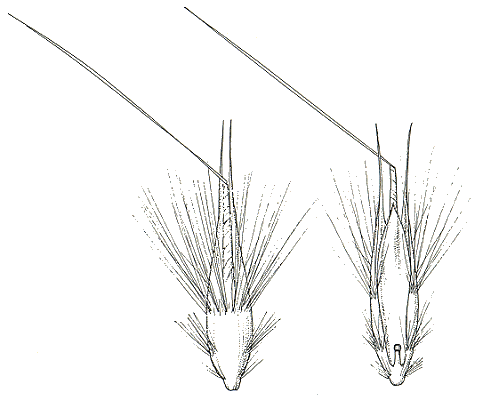 |
 |
|
 |
 |
|

Rytidosperma fortunae-hibernae (Renvoize) Connor & Edgar |
Derivation
Rytidosperma Steud., Syn. Pl. Glum. 1: 425 (1854); from the Greek
rhytis (wrinkle) and sperma (seed), referring to the back of a
larva mistaken for the seed.
fortunae-hibernae- Latin for luck of the Irish.
Published in
New Zealand J. Bot. 17: 332 (1979).
Common synonyms
Danthonia fortunae-hibernae Renvoize
Habit
Perennial, tufted. Rhizomes elongated. Basal leaf sheaths papery. Young shoots
intravaginal. Culms erect or geniculately ascending, 20–38 cm tall. Leaf-sheaths
glabrous on surface. Ligule a fringe of hairs. Leaf-blades 6–15 cm long,
1–2 mm wide. Leaf-blade surface glabrous or pilose. Leaf-blade apex acute.
Inflorescence
Inflorescence solid, a panicle. Peduncle scaberulous above. Panicle contracted,
oblong or ovate, 2–3.5 cm long. Panicle branches scaberulous.
Spikelets
Spikelets solitary. Fertile spikelets many flowered, comprising 2–4 fertile
florets, with diminished florets at the apex, cuneate, laterally compressed,
7–11 mm long, breaking up at maturity. Spikelets disarticulating below
each fertile floret.
Glumes
Glumes persistent, similar, thinner than fertile lemma. Lower glume ovate, 7–11
mm long, equalling upper glume, membranous, purple, 3–5-nerved.
Lower glume apex acute. Upper glume ovate, 8–11 mm long, membranous, purple,
3–5-nerved. Upper glume apex acute.
Florets
Fertile lemma ovate, 1.4–8 mm long, chartaceous, pallid. Lemma surface
villous, with 2 transverse rows of hair tufts. Lemma margins ciliate. Lemma
apex lobed, 2-fid, with lobes 3–5 mm long, setaceously acuminate, 1-awned.
Median (principal) awn from a sinus, geniculate, 5.4–10 mm long overall,
with a twisted column. Palea 2.6–4.2 mm long. Apical sterile florets resembling
fertile though underdeveloped. Lodicules 2, fleshy. Anthers 3. Grain with adherent
pericarp, obovoid, 1.3–1.5 mm long. Embryo 50% of length of grain.
Hilum punctiform.
Continental Distribution:
Australasia.
Australian Distribution:
Tasmania: West Coast, Central Highlands, South West, Mt Field.
Classification. (GPWG
2001):
Danthonioideae
Notes
Tasmanian endemic, altitude 1100–1300 m, rock crevices and stony road margins
at high altitudes; recorded from forests, cliffs and heaths in the subalpine.
Flowers Feb.

Lemma and palea (line drawing)
© Australian Biological Resources Study
drawing by C.E. Smith